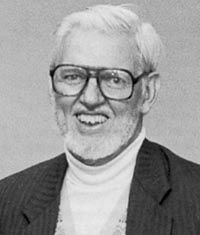1922 — 2005
by Paul M. DeLuca, Jr., and James Zagzebski

The health physics and medical physics community lost a great leader and founding father with the passing of John R. Cameron, Emeritus Professor of Medical Physics at the University of Wisconsin (UW)-Madison.
John was an Emeritus Fellow of the Health Physics Society (HPS), associate editor of Health Physics (1976-1979), president of the North Central Chapter HPS (1968), and a frequent contributor to Health Physics News.
He was a founding member of the American Association of Physicists in Medicine (AAPM) and served as its 10th president in 1968.
John died on 16 March 2005 at age 82 in Gainesville, Florida, where he lived during the winter months and served as a Visiting Professor in the Department of Radiation Oncology at the University of Florida.
John, born in northern Wisconsin in 1922, was raised on a farm and experienced firsthand the Depression years. In 1937 his parents moved to Superior so that he and his seven siblings could attend college. After enrolling at UW-Superior, John's education was interrupted by service in the U.S. Army Signal Corps from 1941 to 1946. After the war, he enrolled at the University of Chicago and received a BS degree in mathematics in 1947.
Subsequently John moved to Madison and received his PhD in physics in 1952, with the thesis title "Elastic Scattering of Alpha Particles by Oxygen." Despite John's protestations about the usefulness of his thesis research, these cross sections are still used today in ion beam implantation work. As an assistant professor at the Universidad de São Paulo in Brazil, John established many lifelong friendships. After a brief stint of post-doctoral work at UW-Madison, he became an assistant professor at the University of Pittsburgh (1956-1958). Finally, in 1958 John joined the faculty of the Department of Radiology at Madison, accepting an assistant professor position, with a joint appointment in the Department of Physics.
Thus began an illustrious career in medical physics. For the next three decades, John guided the UW Medical Physics Program from a "one physicist" operation to one of the largest and most productive in the world. Presently there are 21 faculty and 8 postdoctoral appointees training 86 students. Since its founding in 1958, the program has awarded more than 185 PhD and 156 MS degrees. Graduates and trainees have become leading medical physicists—a source of great personal pride for John. The program was awarded departmental status in 1981, the first medical physics program to receive departmental status in the United States. John served as chair until his retirement in 1986.
John is widely recognized for several innovative and seminal contributions to medical physics. He investigated and advanced thermoluminescence dosimetry, establishing most of the principal characteristics needed for wide applicability. This technology became the standard for personal radiation monitoring, eventually largely replacing traditional film densitometry.
At about the same time, John invented bone densitometry, which uses precise radiation measurements to determine the mineral content of bone. Since the radiation doses were very small, his graduate students often used family members (and each other) as "research subjects." A small change in a lactating mother's bone mineral was easily observed. One of his early bone densitometry publications (Invest. Radio. 3:141; 1968) was listed as its single most cited article on the 25th anniversary of Investigative Radiology. Many useful clinical applications of highly accurate bone densitometry became evident and a number of companies developed bone densitometers. Lunar Radiation (now GE-Lunar) arose directly from early work done in John's "bone mineral lab." The number of bone densitometers in the world now exceeds 20,000.
John was deeply concerned with excess radiation exposures in diagnostic radiology. He developed simple test tools and techniques to measure radiation and to evaluate the quality of x-ray images. These efforts led to the creation of Radiation Measurements, Inc. (RMI), a pioneering manufacturer in quality-assurance measurements, materials, and devices. This also led to product developments by several companies and to several standard techniques for radiation measurement and image quality assurance.
More recently, John founded Medical Physics Publishing, a nonprofit corporation whose initial objectives were to provide reprints of useful but out-of-print books. That company now publishes a wide spectrum of original books and is a major source of material relating to health physics and medical physics.
John was interested in developing new applications of physics to medicine. He preferred to hire new faculty whose research was not in the mainstream at the time. John started a program for radiation physics measurement that with federal funding became the Midwest Center for Radiation Physics. His foresight led to the early development of significant programs at UW-Madison in applications that eventually became "mainstream," including ultrasound, positron imaging, and digital angiography, to name but a few. He also helped initiate a program in magneto-encephalography, looking at the magnetic signals emitted by the brain. After his retirement, his interests spread into still more areas, including imagination and creativity.
While an outspoken advocate for reductions in diagnostic radiation exposures, John was equally concerned about the excess and unwarranted concerns about near-background levels of radiation exposure. In recent years he devoted himself to educating the public accurately about the benefits and risks of radiation used in medicine. He was especially concerned about the fear caused by low-level radiation and analyzed much data to illustrate that these fears probably are unfounded. He argued this aspect by talking about longevity being a measure of health effects of radiation (Radiology 229:14-16; 2003). Indeed, he argued (convincingly) that radiation might be a beneficial "trace element" at very low doses (Physics and Society October 2001).
John was chairman of the Bureau of Radiological Health, Food and Drug Administration Training Grants and Review Committee (1973-1974), a member of the Technical Advisory Panel for the Nuclear Shipyard Workers Study, Johns Hopkins University (1981-1986), a member of the Radiation Advisory Committee for Pennsylvania Power and Light (late 1980s), and a consultant to the United States Atomic Energy Commission and to the International Atomic Energy Agency (1967-1978).
John received numerous honors for his contributions to medical physics, including the Coolidge Award from the AAPM in 1980. In 1995 he was one of only four recipients of a Roentgen Centennial Medal Award from Radiological Society of North America. In 2000 John received from the International Organization for Medical Physics the Madam Curie Award for activities in medical physics education in developing countries.
For all of his research and professional contributions, John's greatest legacy is the many students, trainees, and young faculty whose budding careers were nurtured in the UW Medical Physics Program. He was a caring and generous man who went out of his way to ensure that all of these young people had the best opportunity possible to develop their careers in medical physics. He was full of optimism and had a great sense of humor, catching many students by surprise as he taught them. Every graduate or trainee of the UW Medical Physics Program owes a debt of gratitude to John for his efforts on behalf of them and of the UW program.
Among his many attributes, John is legendary for two others. John took great pride in his Scottish frugality and would demonstrate it in a humorous manner. Also John had a philosophy that he used to inspire his students and others. He would always quote in the middle of a trying time during an experiment, "Anything worth doing is worth doing poorly," meaning, "It doesn't have to be perfect, just get it to work!" More than once this was enough to spur on his student to "just do it" and not worry about perfection. Perfection could always come later if necessary.
John is survived by his wife of 58 years, Von (Lavonda), two daughters, Ann Marie and Carol, and their spouses. They devoted much care and were of great support to him during his final illness. We extend our sincerest condolences to them.
He will be greatly missed.






